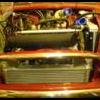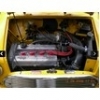I know its not really the done thing, but I have seen lots of posts filling the bags themselves with air under water to check for leaks as with a tyre, but would it do any harm to fill the whole system with compressed air just to see if it holds pressure (for static testing purposes only, not to be driven on)? I don't have access to a hydrolastic pump but dont want to go buying a heap of stuff for it to find out the system is knackered anyway and loses pressure in a week.
Thanks, Clive


















